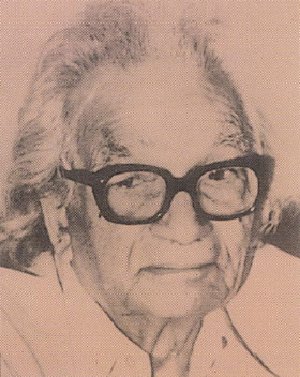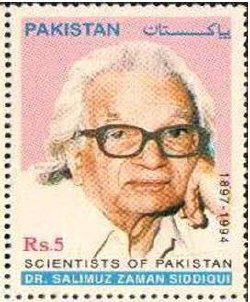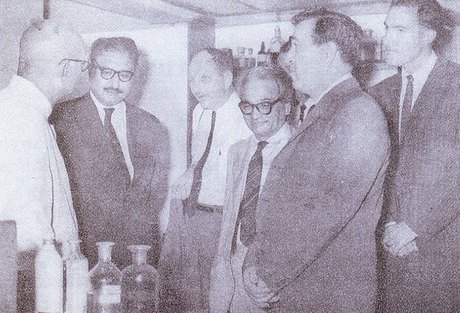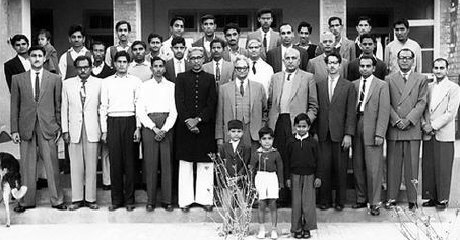 It was in the wee hours of morning that the telephone rang. I am talking about the late 50s when having the landline telephone was a sign of luxury. My grandfather picked up the phone waking up from deep sleep and with a fear in his heart that something has gone wrong somewhere.
It was in the wee hours of morning that the telephone rang. I am talking about the late 50s when having the landline telephone was a sign of luxury. My grandfather picked up the phone waking up from deep sleep and with a fear in his heart that something has gone wrong somewhere.
The voice on the other side pleaded to him, “Salam, for God’s sake bring him back from the lab. He is there for the past four days.”
Within five minutes, my grandfather was in his Morris Minor driving down to Karachi University. The person on the other line was the German wife of Dr. Salimuzzaman Siddiqui. When all things fail, she used to call my grandfather to practice his fine arts of persuasion to bring Dr. Siddiqui out of his lab where he was totally immersed in his work and losing all context of time.
This story has been narrated to me by my late grandmother. I was just a twinkle in my father’s eyes.
I was reading an interview of Dr. Siddiqui where he mentioned the importance of hard work and research and narrated an event when one of the scientist was disheartened as he/she was doing research for over one year on a certain assignment which was not going anywhere. Dr. Siddiqui explained his own experience when he worked for years and finally found out his original premises was not correct. The job of the scientist, he argued, is to dedicate himself to pure research and hard work. Nobody can control the results.
His life was a true embodiment of this principle.
 Born in a well known family of Subeha (Barabanki District) near Lucknow on 19 October 1897, he received his early education in Urdu and Persian. He also developed interest in literature, poetry and calligraphy from his father Sheikh Mohammad Zaman. His elder brother Choudhry Khaliq-uz-Zaman was a famous leader of the Pakistan Movement. The young Salim uz Zaman and his family has been mentioned affectionately by QuratulAin Hider in her autobiography “Kar-e-jahan Daraaz Hai” as they were quite known in Lucknow society. After getting his graduation in Persian and Philosophy (a very interesting choice for one of the brightest minds of chemistry), he proceeded to England to persue medicine.
Born in a well known family of Subeha (Barabanki District) near Lucknow on 19 October 1897, he received his early education in Urdu and Persian. He also developed interest in literature, poetry and calligraphy from his father Sheikh Mohammad Zaman. His elder brother Choudhry Khaliq-uz-Zaman was a famous leader of the Pakistan Movement. The young Salim uz Zaman and his family has been mentioned affectionately by QuratulAin Hider in her autobiography “Kar-e-jahan Daraaz Hai” as they were quite known in Lucknow society. After getting his graduation in Persian and Philosophy (a very interesting choice for one of the brightest minds of chemistry), he proceeded to England to persue medicine.
However upon the advice of his elder brother to study Chemistry in Germany as they were the best in Chemistry, he later decided to go to Germany to study Chemistry and completed his PhD in 1927. In 1924, he married his German classmate, Ethel Wilhelmina Schneeman (who changed her name to Talat and was nicknamed Tilly). One of the interesting fact of that stay is that Ch. Khaliquzzaman provided him Rs. 10,000 for his expenses and when they were eaten up by inflation, Hakim Ajmal Khan arranged Rs. 400 per month for him to complete his studies.
Upon his return to India, he established and became the first director of Ayurvedic and Unani Tibbi Research Institute at the Tibbia College Delhi, under the guidance of Hakim Ajmal Khan. (This very fact shows the emphasis over research being shown by the Hakims of Dehli. The same tradition was followed by Hakim Saeed in Pakistan and his brother Hakim Hameed in Dehli through Hamdard Foundation.) He was able to observe the various plants and herbs being used by the great Hakim as medicine for various ailments.
Some great names of Pakistan science. Top: Dr. Salimuzzaman Siddiqui and Dr. Abdus Salam at the PCSIT. Bottom: Dr. Salimuzzaman Siddiqui, Dr. Nazir Ahmed and Dr. Raziuddin Siddiqui (possibly also Dr. I.H. Usmani). More here.
He observed that Hakim Ajmal Khan used snakeroot for ailment of mental disorders. He started his research and his first breakthrough came when he successfully isolated an antiarrhythmic agent in 1931 from the roots of Rauwolfia serpentina. He named the newly discovered chemical compound as Ajmaline, after his mentor Hakim Ajmal Khan. Later on, Siddiqui also extracted other alkaloids from Rauwolfia. Many of these are still used worldwide for treatment of mental disorders and cardiovascular ailments, especially as antiarrhythmic agents in Brugada syndrome. After the death of Hakim Ajmal, he joined Indian Council of Scientific and Industrial Research and later migrated to Pakistan in 1951 upon the request of Prime Minister Nawabzada Liaquat Ali Khan.
He later shifted his focus to Neem. Salimuzzam Siddiqui was the first scientist to bring the anthelmintic, antifungal, antibacterial, and antiviral constituents of the Neem tree to the attention of natural products chemists. In 1942, he extracted three bitter compounds from Neem oil, which he named as nimbin, nimbinin, and nimbidin respectively. From 1942 to the end of his career, he was able to identify and isolate 50 chemical compounds (patented in his name) from Neem just as a result of his own research in addition to those discovered as a result of his joint research with other colleagues and students. Most of these discoveries still remain vital natural ingredients of various medicines as well as biopesticides. In acknowledgement of these revolutionary discoveries, he was awarded the Order of the British Empire (OBE) in 1946.
Dr. Salimuzzaman was given the task of fostering scientific research activities in Pakistan. In 1953, he founded the Pakistan Academy of Sciences as a non-political think tank of distinguished scientists in the country. He also served as one of the founding member of Pakistan Atomic Research Commission in 1956 and established Pakistan Council of Scientific and Industrial Research (PCSIR) in Karachi. He was awarded various medals by the Government and the Frankfurt University for organizing scientific activity in Pakistan. An interesting point to note is that both Dr. Salimuzzaman and Ch. Khaiquzzaman are perhaps the only brothers in the history of Pakistan to have received Hilal-e-Pakistan medal.
In 1967, Siddiqui was invited by University of Karachi to set up a Postgraduate Institute of Chemistry in affiliation with the Department of Chemistry. He was designated as the institute’s Founder Director, whereas the additional research staff was provided by PCSIR. In 1976, the institute was offered a generous donation from Hussain Jamal Foundation, as a result of which it was renamed as Hussain Ebrahim Jamal (HEJ) Research Institute of Chemistry.
In due time, Siddiqui transformed the institute into a distinguished centre of international excellence in the field of chemistry and natural products. In March 1975, he headed the National Commission for Indigenous Medicine. His tireless efforts for the promotion of science and technology earned him Hilal-e-Imtiaz, Sitara-i-Imtiaz, Hilal-i-Pakistan and Pride of Performance from the Government of Pakistan in 1980. In 1983, he played a major role – along with Dr. Abdus Salam – in the establishment of the Third World Academy of Sciences and became one of its Founding Fellow. He remained the director of the HEJ Research Institute of Chemistry until 1990 when he turned the reins to Dr. Ata Ur Rehman. However, he continued research in his personal laboratory.
Dr. Salimuzzam Siddiqui, in the tradition of many other great scientists, was interested in more than just sciene. He was a refined poet, musician, and a painter. In August 1924, he held his first international exhibition of paintings in Frankfurt. Later in 1927, his works of art were exhibited at the Uzielli Gallery, Frankfurt. During his stay in Germany, he also translated Rainer Maria Rilke’s poetry into Urdu, which was published in the journal of Jamia Millia Islamia. Though, his passion for arts was superseded by the enthusiasm in scientific research, he continued to patronize arts and culture. In 1966, he was at the forefront for setting up the Central Institute of Arts and Crafts in Karachi. He also compiled a selection of poetry of Mir Taqi Mir into Intekhab-e-Meer. In 1983, he published a portfolio collection of charcoal drawings from 1920 to 1950s.
I still remember when he attended a literary program of PTV where he spent about half an hour just explaining the meaning of the first line of Ghalib’s Divan Naqsh Faryadi hai kis ki shauqi-e-tehreer ka (About whose mischievousness of writing is the image a plaintiff). He traced the origin of this line to the first couplet of Misnavi Maulana Raum:
Listen to the reed of the flute, how it a long complaint makes:
it, explanation of the tale of separation, loud and faint makes…
“Ever since the time that I was torn away from the reed’s bed
my cries have caused men and women… many a sigh to shed”.
He also related this to the Sufi philosophy of Wahdatul Wajood, that we are all part of the same light and we all feel unhappy as in our physical form we are being separated from the great light or noor. His method of explanation was so simple that it is still fresh in my memory after quarter of a century.
Dr. Siddiqui breathed his last on April 14, 1994 at the age of 97. His continuing legacy, perhaps are his great students who are continuing the fine traditions of research and service to humanity taught to them by this great scientist and human being. Perhaps Sadequein’s rubayi hold true in Dr. Salimuzzaman case too.
Chalo es baar Saahiri kar kay dekhoon
Kia farq hai shyari kar kay dekhon
Tasweeron mein ashaar kahen hein mein nay
Shayari mein mussawari kar kay dekhon.
1. Special Thanks to Dr. Ghulam Nabi Kazi and Obaid-ur-Rehman Advocate for providing and clarifying facts
2. For some rare photos of Dr. Saleemuzzaman please visit Dr. Ghulam Nabi Kazi’s photo stream.
3. The author blogs at Ayaz Abdal’s blog





















































Good to see this post and learn about his work. I had known his name but not really known much about him. Glad you write about him and highlighted his achievements.
By the way, it was in 1983 or 84 that I must have encountered Dr. Siddiqui
I remember meeting Dr. Saleemuzzaman in Karachi once at a gathering I had gone to with my father. I am sorry to say that I did not know who he was but I remember being mesmerized by him and the discussion, which was mostly on poetry. Later, I remember my father being annoyed with me for not even knowing who this man was. I remember he went on about the bad education we were getting if we did not even know about him. I guess he was right. I am glad that I now know more about him.